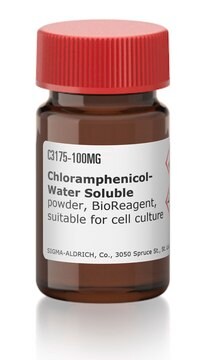220551
Chloramphenicol
Chloramphenicol, CAS 56-75-7, is a synthetic bacteriostatic antibiotic that inhibits the translation of RNA by blocking the peptidyltransferase reaction on ribosomes.
Synonim(y):
Chloramphenicol
About This Item
Polecane produkty
Poziom jakości
Próba
≥97% (by Assay)
Formularz
crystalline powder
producent / nazwa handlowa
Calbiochem®
warunki przechowywania
OK to freeze
kolor
gray to off-white
rozpuszczalność
water: 2.5 mg/mL
methanol: 35 mg/mL
ethanol: soluble
Warunki transportu
ambient
temp. przechowywania
10-30°C
InChI
1S/C11H12Cl2N2O5/c12-10(13)11(18)14-8(5-16)9(17)6-1-3-7(4-2-6)15(19)20/h1-4,8-10,16-17H,5H2,(H,14,18)
Klucz InChI
WIIZWVCIJKGZOK-UHFFFAOYSA-N
Opis ogólny
Działania biochem./fizjol.
trasnslation of RNA
Inne uwagi
Lu, J., and Jiang, C. 1993. Biochem. Biophys. Res. Commun.196, 12.
Saltarelli, M.J., et al. 1993. Virol.197, 35.
Holt, J.T. 1992. Ann. N.Y. Acad. Sci.660, 88.
Maniatis, T., et al. 1989. In Molecular Cloning, A Laboratory Manual, Second Edition. Cold Spring Harbor, NY, p. 1.6, A.6.
Informacje prawne
Hasło ostrzegawcze
Danger
Zwroty wskazujące rodzaj zagrożenia
Zwroty wskazujące środki ostrożności
Klasyfikacja zagrożeń
Carc. 2 - Eye Dam. 1 - Repr. 2
Kod klasy składowania
11 - Combustible Solids
Klasa zagrożenia wodnego (WGK)
WGK 3
Certyfikaty analizy (CoA)
Poszukaj Certyfikaty analizy (CoA), wpisując numer partii/serii produktów. Numery serii i partii można znaleźć na etykiecie produktu po słowach „seria” lub „partia”.
Masz już ten produkt?
Dokumenty związane z niedawno zakupionymi produktami zostały zamieszczone w Bibliotece dokumentów.
Klienci oglądali również te produkty
Powiązane treści
Exploring genotoxicity and DNA damage through multiplexing with MILLIPLEX® multiplex genotoxicity assays using Luminex® xMAP® technology enables the high-throughput measurement of phosphorylation levels of multiple proteins simultaneously and reduces sample volume, time, and cost.
Nasz zespół naukowców ma doświadczenie we wszystkich obszarach badań, w tym w naukach przyrodniczych, materiałoznawstwie, syntezie chemicznej, chromatografii, analityce i wielu innych dziedzinach.
Skontaktuj się z zespołem ds. pomocy technicznej







